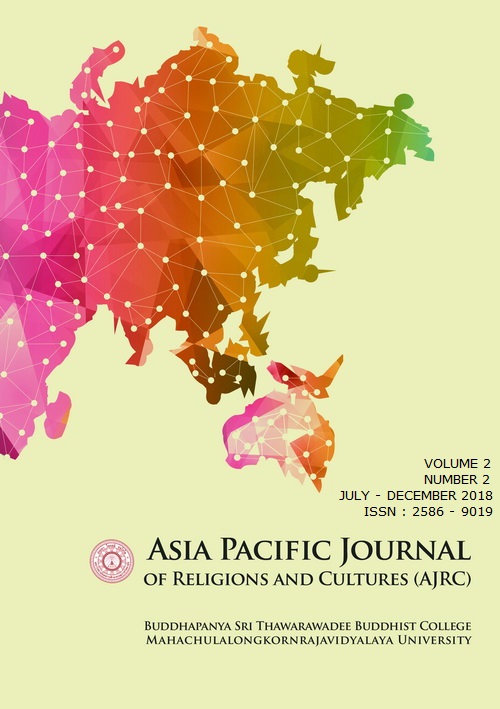The Amuletic Small Buddha Images: Concepts, History and Cultural Development
Main Article Content
Abstract
Theses topics on “The Small Buddha Images: ideas, history, and the cultural development” have three purposes; namely, (1) to study the ideas, history of these images’ construction by Thai societies, (2) to study the procedure of meaningful expression and their values in Thai civilization and culture, 3) to analyze the Buddha images in terms of the societal and cultural dynamic. Especially for the research methodology, this is the qualitative techniques by the data retrieval or recovery related to the historical configuration, analytical processes in an attempt to convey their meanings and values. In addition, the arrangements of focus groups have been prepared, comprised of the archaeological and historical expert groups of Buddhism and Buddha Images in Thai societies amounting to 15-20 monks/men. Subsequently, those data have been analyzed, summarized in consistent with these objectives for the completion of research.
As a result, it has been revealed that the ideas and history of creations were as follows: - they had been supported Buddhism, announced the Buddhism Dharma, acted for gifts (or giving aims/ making of merits for the dead people, called “an intercessional expiratory offering”; otherwise, “donation given to a Holy Persons”, worshiped/offered sacrifice to Buddha grace. According to the history of Buddha images creation; they had been influenced or affected by the formation of Buddha images as Human figures/designs for the first time for 300 – 400 years after the Buddha lifetime. For these reasons, King Milin – the Greek Yonok ancestry’s reign had possessed his ideas so as to create Buddha images as the Buddha representation for respect inherited until now. In terms of the significantly conveying processes and values, it had been revealed that the Buddha images being substituted for both mediums of Buddha, Dharma and consecrated/sanctified Monks and evocative links for all Buddhists coming closer to Buddhism. For the social and cultural dynamic sensibleness, the Buddha images had originated the sacred stimulant for Thai societies, as sub consciousness led to the (Dhammàdhiññhàna) exposition in terms of ideas, subject to the sorrow/suffering extinguishments. Finally, people had possessed and enjoyed their high morale and strength of mind by Buddha sacrosanct grace. These were the procedural changes of fine and glowing culture and societies so far.
Article Details
References
Choncherdpratheep, D. (1970). (Bell–stirring) Metal Buddha image, completed edition. Bangkok: Thai Samphan Press.
Coedes, G. (1983). Legend of Thai Alphabets, Votive Tablet, Excavation at Pong Tuk and Thai Arts in Sukkhothai Era. Bangkok: Kuruspa Ladphrao Press.
Dharmbundarn, W. (2004). Legend of Isosceles Triangle Buddha Images, Bangkok: Amarin Printing Press.
Karjanawat, P. (1982). Small Buddha Images, as the Amulet. Bangkok: Aksorn Samphan Press.
Kumwansa, S. (1979). Influence of Indian Culture in Southeast Asia: Thailand. Bangkok, Aksorn Charoenthat Press.
Lohpetchrat, S. (2003). Analysis of History of Buddha Veneration and Arts of Buddha Statue in Asia. Bangkok: Amarin Printing and Publication.
Phra Dharmpidok, (P.A. Payutto). (1989). Asoka Stone Inscription. Bangkok: Amarin Printing Group.
Royal Institute. (2003). Thai Dictionary Edition of Royal Institute B.E.2542. Bangkok: Nan Mee Book Publication.
Saisingh, S. (2004). Dhavaravati Arts: Buddhism Culture Primeval Era in Thai territory. Bangkok: Ancient City Press.
Samakkarn, S. (1996). Belief and Religion in Thai Society. Bangkok, Odeon Store.
Sarikabhutra, T. (1966). Buddha Jubilee Ceremony Amulet: The Consecrated/Chanted Amuletic Small Buddha Images. Bangkok: Silpabannakarn Press.
Somdej Krom Phraya Damrong Rajanubhab. (2002). Legend of Buddha Pagodas. Bangkok: Matichon.
________. (2002). Siamese Pagoda Legend, Bangkok: Matichon Press.
Soontaravanich, C. (2008). Innovation of Thai Amuleic Small Buddha Images: Prior to being industry. Bangkok: Matichon Press.
Wallipodom, S. (1994). Amuletic Small Buddha Images in Siam. Bangkok: Matichon Press.
Yamnatda, S. (1999). Amuletic Small Buddha Images. Bangkok: Siam Press Management.


